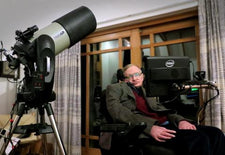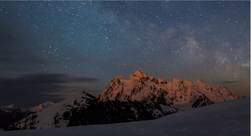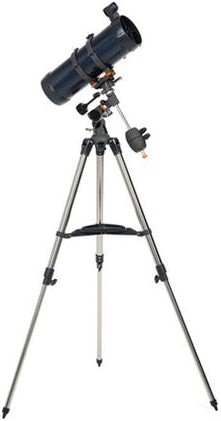Polar Alignment
May 4, 2015
If you're like most new amateur astronomers, the first thing you probably do when you get your new telescope properly assembled is put in an eyepiece and point it up to look at the moon. Just the excitement of seeing the lunar landscape up close is enough to keep you entertained for days. But eventually, as you progress to finding more difficult objects, such as planets and faint deep-sky objects, you will want to utilize all the features of your equatorial mount, such as the setting circles or perhaps even a motor drive. A mount is said to be "equatorial" if one of its two axes can be made parallel with the Earth's axis of rotation. Aligning the telescope to the Earth's axis can be a simple or rather involved procedure depending on the level of precision needed for what you want to do. For casual observing, only a rough polar alignment is needed. Better alignment is needed for tracking objects across the sky (either manually or with a motor drive) at high magnifications. Still greater precision is needed in order to use setting circles to locate those hard-to-find objects. Finally, astrophotography will require the most accurate polar alignment of all.
Theory
The polar alignment procedure works on one simple principle: The polar axis of the telescope must be made parallel to the Earth's axis of rotation, called the North Celestial Pole (NCP). When this is accomplished, the sky's motion can be canceled out simply by turning the axis (either by hand or with a motor drive) at the same rate as the rotation of the Earth, but in the opposite direction. Although residents of the northern hemisphere are convenienced with a bright star (Polaris) less than a degree from Earth's rotational axis, the NCP can still be a somewhat elusive place to locate.

Rough Polar Alignment

For ordinary visual observing, the telescope's polar axis must be aligned to the Earth's pole. This simply means positioning the telescope so that the polar axis is aimed up at Polaris. The easiest way to accomplish this is to rotate the telescope tube to read 90degrees in declination. In this position the telescope will be parallel to the polar axis. Now, move the telescope, tripod and all, until the polar axis and telescope tube are pointed towards Polaris. Finally, match the angle of your telescope's polar axis to the latitude of your observing location. Most telescopes have a latitude scale on the side of the mount that tells you how far to angle the mount for a given latitude (see your telescope owner's manual for instructions on how to make this adjustment). This adjustment determines how high the polar axis will point above the horizon. For example, if you live at 40degrees latitude, the position of Polaris will be 40 degrees above the northern horizon. Remember your latitude measurement need only be approximate; in order to change your latitude by 1degree you would have to move your observing position by 70 miles! Polaris should now be in the field of view of an aligned finderscope. Continue making minor adjustments in latitude and azimuth (side to side), centering Polaris in the finder's cross hairs or low power eyepiece. This is all that is required for a polar alignment good enough to use your telescope's slow motion controls to easily track a star or planet across the sky. However, in order to take full advantage of the many features of your telescope (such as setting circle and astrophotography capability) a more precise polar alignment will be necessary.
Accurate Polar Alignment Before we can be certain that the telescope's polar axis is accurately aligned with the rotational axis of the Earth, we must first be certain that the finderscope (which will actually be used to polar align the mount) is aligned with the telescope's polar axis.
For polar alignment purposes, the finderscope itself can be used to accurately align the mount's polar axis by adjusting the finder inside its bracket. This is quite simple since the finder is easily adjusted using the screws that hold it inside the bracket. Also, thefinderscope's wide field of view will be necessary for locating the position of the North Celestial Pole relative to Polaris. Here's how it's done:
Set up your mount as you would for polar alignment. The DEC setting circle should read 90 degrees . Rotate the telescope in Right Ascension so that the finderscope is positioned on the side of the telescope tube. Adjust the mount in altitude and azimuth until Polaris is in the field of view of the finder and centered in the cross hairs.
Now, while looking through the finderscope, slowly rotate the telescope 180 degrees around the polar axis (i.e. 12 hours in Right Ascension) until the finder is on the opposite side of the telescope. If the optical axis of the finder is parallel to the polar axis of the mount, then Polaris will not have moved, but remain centered in the cross hairs. If, on the other hand, Polaris has moved off of the cross hairs, then the optical axis of the finder is skewed slightly from the polar axis of the mount. If this is the case, you will notice that Polaris will scribe a semi-circle around the point where the polar axis is pointing. Take notice how far and in what direction Polaris has moved.
Using the screws on the finder bracket, make adjustments to the finderscope and move the cross hairs halfway towards Polaris' current position (indicated by the "X" in Figure B below). Once this is done, adjust the mount itself in altitude and azimuth so that Polaris is once again centered in the cross hairs. Repeat the process by rotating the mount back 180 degrees , and adjusting the finder bracket screws until the cross hairs are halfway between their current position and where Polaris is located, and then centering Polaris in the cross hairs by adjusting the mount in altitude and azimuth. With each successive adjustment the distance that Polaris moves away from center will decrease. Continue this process' until Polaris remains stationary in the cross hairs when the mount is rotated 180 degrees. When this is done, the optical axis of the finderscope is perfectly aligned with the polar axis of the mount. Now the finder can be used to polar align the mount.
So far we have accomplished aligning the polar axis of the telescope with the North Star (Polaris), but as any star atlas will reveal, the true North Celestial Pole (NCP) lies about 3/4 degrees away from Polaris, towards the last star in the Big Dipper (Alkaid). To make this final adjustment, the telescope mount (not the telescope tube) will also need to be moved away from Polaris towards the actual NCP. But the question is; since Polaris makes a complete rotation around the Celestial Pole once a day, how far should the mount be moved and in what direction? Let's take an example: suppose you are out observing on August 1 st at 8:00 p.m.. A quick inspection of the northern sky will reveal that the last star in the handle of the Big Dipper, Alkaid, lies above and to the left of Polaris in the 10 o'clock position. Now, while looking through the finderscope (with Polaris still centered in the cross hairs) adjust the latitude and azimuth of the mount up and to the left until Polaris also moves up and to the left in your straight through finderscope. (Remember a straight through finder inverts the image, so Polaris will appear to move in the same direction as the mount is moved). How far to move Polaris will depend on the field of view of the finderscope. If using a finderscope with a 6 degree field of view, Polaris should be offset approximately 1/3 of the way from center to edge in the finder's view (i.e. half of the field of view, from center to edge, equals 3 degrees and 1/3 of that equals 1 degree ). This calculation can be approximated for any finderscope with a known field of view.

The mount's setting circles can now be used to determine just how close the polar axis is to the NCP. First, aim the telescope tube (be careful not to move the mount or tripod legs) at a bright star of known right ascension near the celestial equator. Turn the right ascension setting circle to match that of the bright star. Now, rotate the telescope tube until it reads 2 hours 30 minutes (the right ascension of Polaris) and +89 degrees declination. Polaris should fall in the center of the finder's cross hairs. If it doesn't, once again move the mount in latitude and azimuth to center Polaris.
This procedure aligns the telescope mount to within a fraction of a degree of the NCP; good enough to track a star or planet in a medium power eyepiece without any noticeable drift. However, long exposure astrophotography is far less forgiving and film will easily reveal even the smallest amount of motion. At this point, you may be wondering why bother polar aligning any more accurately if you can use the slow motion controls or drive corrector to keep a guide star centered in the cross hairs of an eyepiece. Unfortunately, keeping the guide star centered in the cross hairs is only half the battle. Since, the polar axis is not perfectly in line with the Earth's axis, the stars in the field of view will slowly rotate as you guide. You will get a sharp image of the guide star, but the other stars on the photograph will appear to rotate around the guide star. This is also why you cannot accurately do guided photography with an Altitude-Azimuth (Altazimuth) style mount.
The above method of polar alignment is limited by the accuracy of your telescope's setting circles and how well the telescope is aligned with the mount. The following method of polar alignment is independent of these factors and should only be undertaken if long-exposure, guided photography is your ultimate goal. The declination drift method requires that you monitor the drift of selected stars. The drift of each star tells you how far away the polar axis is pointing from the true celestial pole and in what direction. Although declination drift is simple and straight-forward, it requires a great deal of time and patience to complete when first attempted. The declination drift method should be done after the previously mentioned polar alignment steps have been completed.
To perform the declination drift method, you need to choose two bright stars. One should be near the eastern horizon and one due south near the meridian. Both stars should be near the celestial equator (i.e., 0 degrees declination). You will monitor the drift of each star one at a time and in declination only. While monitoring a star on the meridian, any misalignment in the east-west direction is revealed. While monitoring a star near the east horizon, any misalignment in the north-south direction is revealed. As for hardware, you will need an illuminated reticle ocular to help you recognize any drift. For very close alignment, a Barlow lens is also recommended since it increases the magnification and reveals any drift faster. When looking due south, insert the diagonal so the eyepiece points straight up. Insert the cross hair ocular and rotate the cross hairs so that one is parallel to the declination axis and the other is parallel to the right ascension axis. Move your telescope manually in R.A. and DEC to check parallelism.
First, choose your star near where the celestial equator (i.e. at or about 0? in declination) and the meridian meet. The star should be approximately 1/2 hour of right ascension from the meridian and within five degrees in declination of the celestial equator. Center the star in the field of your telescope and monitor the drift in declination.
If the star drifts south, the polar axis is too far east.
If the star drifts north, the polar axis is too far west.
Using the telescope's azimuth adjustment knobs, make the appropriate adjustments to the polar axis to eliminate any drift. Once you have eliminated all the drift, move to the star near the eastern horizon. The star should be 20 degrees above the horizon and within five degrees of the celestial equator.
If the star drifts south, the polar axis is too low.
If the star drifts north, the polar axis is too high.
This time, make the appropriate adjustments to the polar axis in altitude to eliminate any drift. Unfortunately, the latter adjustments interact with the prior adjustments ever so slightly. So, repeat the process again to improve the accuracy, checking both axes for minimal drift. Once the drift has been eliminated, the telescope is very accurately aligned. You can now do prime focus deep-sky astrophotography for long periods.
NOTE: If the eastern horizon is blocked, you may choose a star near the western horizon, but you must reverse the polar high/low error directions. Also, if using this method in the southern hemisphere, the direction of drift is reversed for both R.A. and DEC.
Even with a telescope with a clock drive and a nearly perfect alignment, most beginners are surprised to find out that manual guiding may still be needed to achieve pinpoint star images in photographs. Unfortunately, there are uncontrollable factors such as periodic error in the drive gears, flexure of the telescope tube and mount as the telescope changes positions in the sky, and atmospheric refraction that will slightly alter the apparent position of any object.
Polar alignment, as performed by many amateurs, can be very time consuming if you spend a lot of time getting it more precise than is needed for what you intended to do with the telescope. As one becomes more experienced with practice, the polar alignment process will become second nature and will take only a fraction of the time as it did the first time. But remember that when setting up your telescope's equatorial mount, you only need to align it well enough to do the job you want.



